Day three! ... time for another ten brand-new Workouts![wcm_nonmember]
Remember that if you're not yet a member of ViolinSchool, you'll need to join to download the 5 Minute Workouts!
Click here to become a member and get full access to all our learning resources![/wcm_nonmember]
It's the second day of Workout Week! Here's today's selection of 5 Minute Workouts for you to enjoy...[wcm_nonmember]
Remember that if you're not yet a member of ViolinSchool, you'll need to join to download the 5 Minute Workouts!
Click here to become a member and get full access to all our learning resources![/wcm_nonmember]
This week at ViolinSchool we're going workout-crazy! We've heard from many of our learners that they've already zipped through all 40 of our 5 Minute Workouts, and are clamouring for more ...
Not familiar with the 5 minute workouts? Read all about them here! >>
... so, to keep ahead of the game, we've been feverishly creating more workouts, and every day for the next four days we're going to be releasing not one, not two ... but TEN brand new 5 Minute Workouts for you to include in your daily practice! That's another 40 workouts, meaning there'll be 80 to choose from in total ... that's a serious amount of exercise!
Let's get started. Here are today's ten new workouts: Numbers 41 to 50 ...[wcm_nonmember]
Remember that if you're not yet a member of ViolinSchool, you'll need to join to download the 5 Minute Workouts!
Click here to become a member and get full access to all our learning resources![/wcm_nonmember]
We've written out the beautiful melody from Chopin's Prelude No. 15, part of his brilliantly characterful collection of 24 Preludes for solo piano, Op. 28.
No. 15 became known as the "Raindrop" prelude due to the repeated pulsing Ab/G# that permeates the whole piece, above which floats a serene, sublime melody. This isn't Chopin's nickname for the piece, apparently he didn't like descriptive titles! But, "Raindrop" does seem like the perfect title ... once you've got the image in your head, it's hard not to think about the plip-plop of raindrops whilst listening to the piece! 🙂 The Chopin version is in Db major ... our version for violin is in D major, a semitone higher ... so we don't recommend that you play along with the original! That wouldn't sound nice! 🙂
We're delighted to present a brand new website for ViolinSchool London:
http://london.violinschool.com/
This new site is separate from our main eLearning platform at www.ViolinSchool.com, and features up to date information about all of our London-based tuition and events, including calendars and booking forms, plus details of our...
Our studio at 15 Palace Street (Victoria) is now open for One to One lessons every day from 10am (already learning with us? Click here for the main online booking form!). Simon teaches Monday to Thursday, and David from Friday to Sunday. Lessons are available until 8pm weekdays most days (10pm weekends). New students - we have a £29 introductory lesson offer until September - full details on this page!
Our new Ensemble Sessions (like the Violin Orchestra, but with smaller groups!) start on Saturday 5th August and run fortnightly throughout August and September. Our full Autumn program including the next Violin Orchestra project will also be announced in a few weeks. Do let us know if there are any particular topics you'd like us to include in our Autumn classes, and keep the suggestions coming for pieces you'd like us to arrange for the Ensembles or the Violin Orchestra!
Here's the address again: http://london.violinschool.com/
Enjoy!
Good Old Days is a lyrical, nostalgic melody in the good old key of C major! Think fond memories and play it like you would sing it – smooth and flowing and mellifluous! ?
Many of our learners have told us that they've now made their way through all thirty of our 5 Minute Workouts and, so, we are delighted to present the next ten, nos. 31-40 (and, oo-er, they're starting to get a bit trickier!) 🙂
ViolinSchool Members - click here to download ALL the 5 Minute Workouts!
Having plenty of variety in your practice is soooo very important. It's tempting to just repeat the same one or two (maybe three!) things every time you practise, day after day, week after week (month after month!). This means that you'll only be focusing on the challenges contained within those few things. And that's why we think it's soooo very important to do something different, something new, every time you practise! This could be a new scale and arpeggio, a new exercise, a new piece of sight-reading, maybe a spot of improvisation, or performing some old repertoire to your cat! Or, you could spend just five minutes on one of our workouts! This way you are guaranteed to be doing something new - finger patterns, bowing patterns, techniques, keys, rhythms, etc. - in every practice session. Loop each line and try (really, really hard!) to improve it with every loop - think about sound, intonation, pulse, rhythm, posture, bow division, etc., etc. - whilst you are looping!
Have a good workout! 🙂
ViolinSchool Members - click here to download ALL the 5 Minute Workouts!
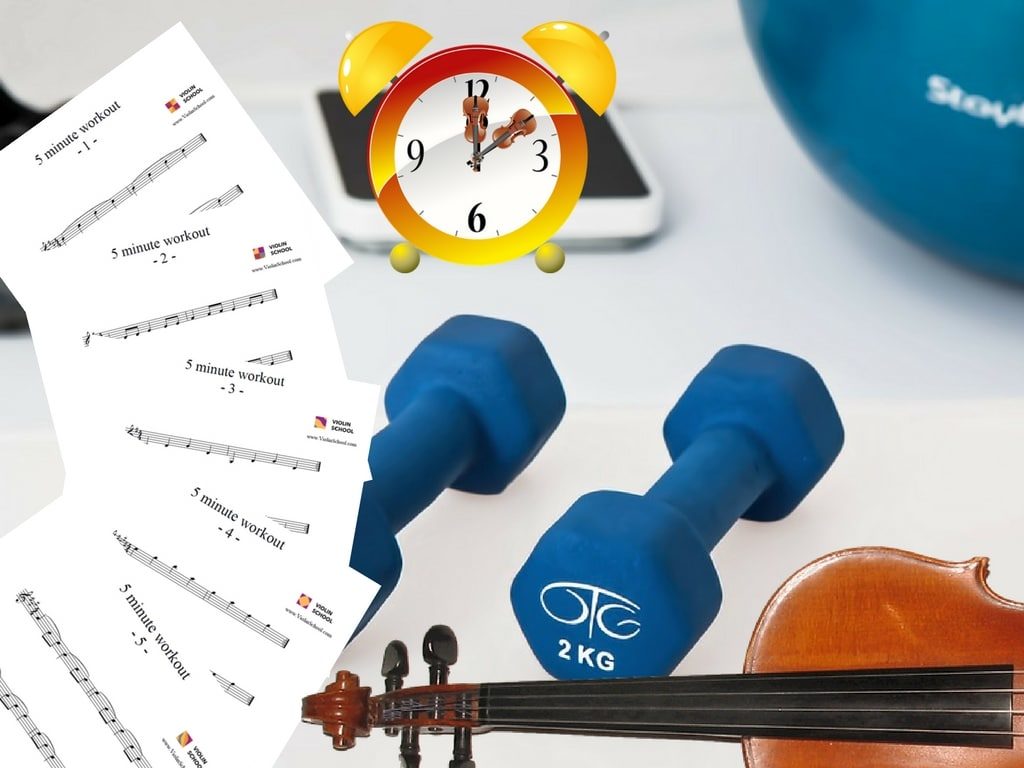
By popular request, we've made a version of the 1st movement Allegro of "Spring" from The Four Seasons by Antonio Vivaldi - (Concerto No. 1 in E major, Op. 8, RV 269, "La Primavera"). We've transposed it from E major into A major (and made a few other little interventions!), so that it can be played entirely in 1st position. You will notice that, for one particular passage, we have provided an 'ossia' - this is an alternative passage, appearing above the stave in smaller print, that can be played instead of the original passage on the main stave. The ossia makes brief use of the 2nd and 3rd positions.
Vivaldi's Four Seasons is one of the earliest, and most vivid, examples of what was later to become known as programme music (or program music!) (or programmatic music!!). Programme music (as opposed to 'absolute music') sets out to depict specific "extra-musical" things - scenes, themes, emotions, atmospheres, dramas, literary texts, legends - music that tells a story. It is designed to evoke particular images and ideas, convey their impressions, invite the listener to make imaginative connections between the music and the world.
In the 1st movement Allegro, Vivaldi brilliantly conjures the essence of Spring:
Springtime is upon us.
The birds celebrate her return with festive song,
and murmuring streams are
softly caressed by the breezes.
Thunderstorms, those heralds of Spring, roar,
casting their dark mantle over heaven,
Then they die away to silence,
and the birds take up their charming songs once more.
These exercises are brilliant for practising double-stopped sixths! Great for intonation work and for developing a really solid left hand. Who doesn’t want a solid left hand?! 🙂
ViolinSchool presents… Scuttlefish, Scuttlefish! featuring gently flowing, tuneful quavers and some startling, accented interjections which - hence the title, we're really pleased with the title 🙂 🙂 - have all the little fishies scuttling for their lives!
For the accented notes, try experimenting with the SPEED of the bow, the WEIGHT/PRESSURE of the bow on the string, and the POINT OF CONTACT where bow meets string between the fingerboard and the bridge --- we know what we think, but see what you think! 🙂 Try to find the combination that makes the most convincing, startling, humorous, vibrant sound. So much of good practice is about trial and error, experimenting creatively with different ingredients. Often, it's just as important to know what NOT TO DO as it is to know what TO DO!
The word 'scuttlefish' can also be used to describe 'a person who is always in haste, who constantly scuttles or scampers apparently for no good reason'. When you practise, don't be a scuttlefish! Take things slowly at first - steady, careful, methodical - and then gradually increase the tempo.
If you're just getting started on the violin, then learning the G, D, and A major scales (and arpeggios!) is a great place to begin, helping you to develop a really solid hand 'frame'. There's a huge amount of violin music in G, D, and A, with most of the major violin concertos being in one of these keys. This is because - along with our friend the E-string - G, D, and A are the notes of the open strings. Happily, in these one-octave versions that start on an open string, the finger pattern is always the same - 0 1 2 3 0 1 2 3 2 1 0 3 2 1 0 - (beware of the semitone between fingers 2 and 3!). Once this pattern is well and truly in your bones, then try using a fourth finger instead of the second open string - 0 1 2 3 4 1 2 3 2 1 4 3 2 1 0.
After watching videos on YouTube of some hilarious and mischievous panda bears, we were inspired to create Playful Pandas. It's a catchy little tune, great for beginner violinists. Play it in all three versions - G major, D major, and A major - so you’re comfortable and confident in all three keys and on all four strings.
ViolinSchool's just celebrated its fifth birthday (!), and the Violin Orchestra its tenth concert! Here's a video from our recent webcast, recorded in London on Saturday 1st July 2017, featuring The Pimlico Players (a Violin Ensemble made up of ViolinSchool learners) and then The Violin Orchestra.
Would you like to join the Violin Orchestra? Find out more at https://www.violinschool.com/violinorchestra/, then come and join us for our next performance in London on Saturday 9th December 2017!
Come ride with us on Prokofiev's Troika! 🙂
We've written out the Troika theme, from Sergei Prokofiev's 'Lieutenant Kijé Suite', in G, D, and A major. It's *such* a great tune, perfect for getting to know the major scale (it uses all eight notes of the one-octave major scale, and not a note more!)
A Troika is a traditional Russian sled or carriage drawn by three-horses side-by-side. Prokofiev took his inspiration for the Troika theme from an old Hussar song... speed it up, throw in some sleigh bells, rapid strumming strings and a trotting piano accompaniment and Prokofiev brilliantly conjures the feeling of a bracing charge through the snowy Russian landscape.
It's hard not to think of Christmas when listening to Troika, not least because legendary prog rocker Greg Lake (of Emerson, Lake and Palmer fame) used it in his Christmas classic, 'I Believe in Father Christmas’.
Enjoy the ride and wrap up warm! 🙂
One of the most popular pieces of music for beginner violinists is Twinkle, Twinkle, Little Star. We've just updated our sheet music so that you can play it in three of the most common keys:
We've written all three versions on the same sheet, so you can learn them all at the same time. And remember, it's exactly the same pattern for each key, so whichever version you're playing (try them all!), you'll always be using the same finger patterns.
ViolinSchool members can download the sheet music from the Twinkle Twinkle Little Star page, where there's also a video tutorial and some fingering guides!
The ViolinSchool Summer Concert is now streaming live on Facebook! Join us here: https://www.facebook.com/violinschool/
The second half of the livestream featuring the Violin Ensembles and The Violin Orchestra will now begin at 3.45pm London time. Tune in at 3.45pm this afternoon to hear THE VIOLIN ORCHESTRA!
Here's the programme for today's concert (click to enlarge):
ViolinSchool wishes to thank WAY ELECTRIFICATION LIMITED for their sponsorship of the Violin Orchestra Summer Concert.
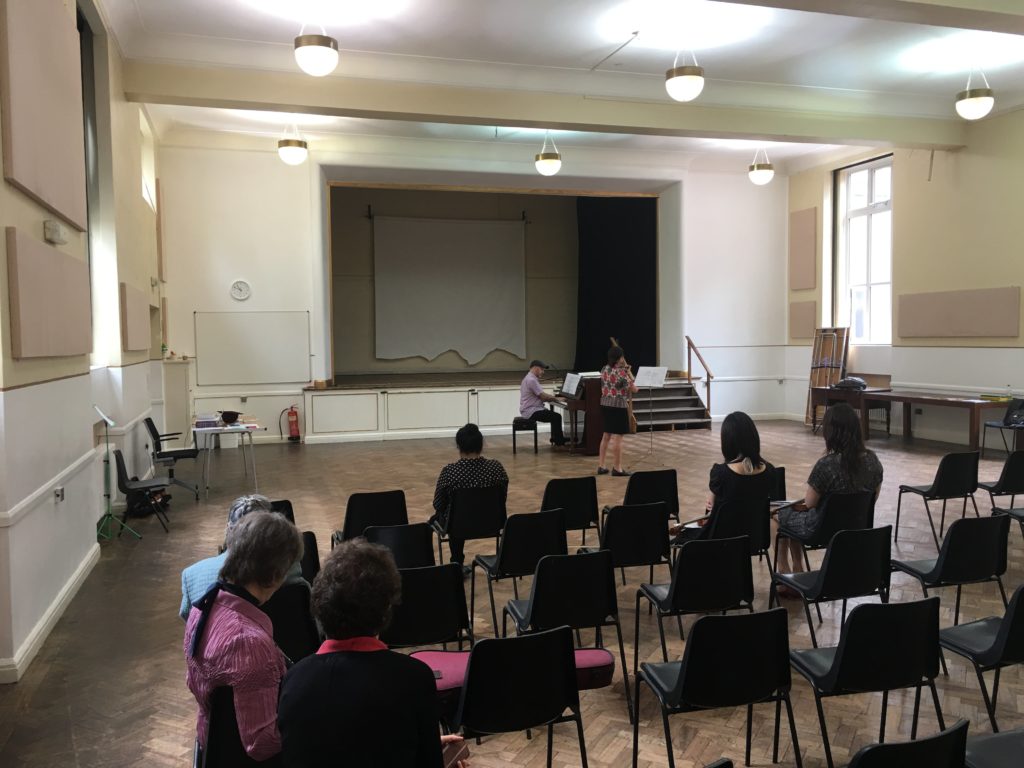 The violins are out! The soundchecks are underway! And in just a couple of hours from now, the Violin Orchestra will be performing live here in London for all to hear!
The violins are out! The soundchecks are underway! And in just a couple of hours from now, the Violin Orchestra will be performing live here in London for all to hear!
Join us from 2pm London time to hear all the ViolinSchool students perform their solos, or 3.20pm for the ensembles and Violin Orchestra itself!
You can catch the livestream on our Facebook page at https://www.facebook.com/violinschool/, and don't forget to share it with the hashtag #violinorchestra!
We look forward to seeing you online later!
ViolinSchool wishes to thank WAY ELECTRIFICATION LIMITED for their sponsorship of the Violin Orchestra Summer Webcast.
We're pleased to announce that ViolinSchool's annual Summer Webcast will take place live from London at 2pm (London time) on Saturday 1st July.
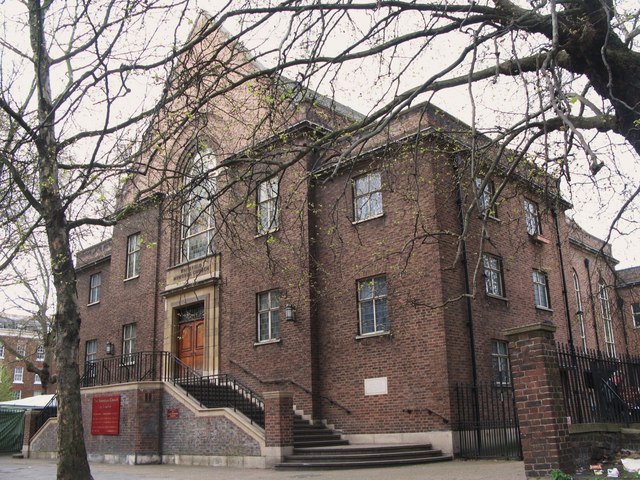
The Violin Orchestra will be performing at Whitefield's Tabernacle on Tottenham Court Road, in the main hall of the American Church in London. The concert will feature a selection of solo performances by members of ViolinSchool, and ensemble performances by the violin ensembles from our Saturday classes, The Pimlico Players.
The Violin Orchestra will then perform exclusive new musical arrangements, written especially for the concert by ViolinSchool's David Worswick, and featuring multi-level parts so that participants of every age and level can join in! The orchestra will be performing:
Advanced players and ViolinSchool members from outside London who wish to come and join us on the day of the concert should get in touch as soon as possible at [email protected], or call us on +44 (0) 20 3051 0080.
The sheet music and concert information is available through this online course page, so that you can learn the repertoire in advance!
Tune in live here at ViolinSchool.com on Saturday 1st July at 2pm London time to watch the concert. Or, come along to 79a Tottenham Court Road, London (entrance around the back on Whitfield Street) to join us at the event! Entry is by donation, no tickets or advanced booking required.
See you there!
ViolinSchool wishes to thank Way Electrification Limited for their sponsorship of the Violin Orchestra Summer Concert
Our awesome Two-Finger Scales provide a serious workout for your left hand! Each of these super-shifting-scales will help you get your left hand moving smoothly between different positions - in the key of your choice. The 3rd and 4th fingers of the left hand benefit particularly strongly ... once you get the muscles moving, you'll feel like you've taken your left hand to the gym!
Don't forget to practise slooooooowly and carefully! What goes up slowly is far more likely to make it down again safely! ...
The Two Finger Scales are available in every key for ViolinSchool Members, so you can download the scale pattern that fits your current repertoire. A few minutes of Two Finger Scales, and you'll be ready to play almost anything!
[pdf-embedder url="https://www.violinschool.com/wp-content/uploads/securepdfs/2017/05/4.-Bb-Major-Bb-Minor-Two-Finger-Scales-ViolinSchool.pdf" title="4. Bb Major & Bb Minor – Two-Finger Scales – ViolinSchool"]
We're pleased to introduce an all-new feature on ViolinSchool.com - Five Minute Workouts!
These great little exercises came about when one of our London learners kept running out of practice time each week because his crazy-busy job in the City of London meant that he barely had any time to practice each day!
He tried to cram in all his practice at the weekend, but it wasn't really working... it's always better to practice 'little and often' rather than in one big chunk. That way you'll remember what you learn much more easily - and you'll be able to build habits more quickly and effectively. So instead, we persuaded him to put aside 5 minutes a day for his practice - literally, just 5 minutes!
To make things as easy as possible, we created a series of '5 minute workouts' so that he didn't have to think about what to practice. Each day, he'd take one of these workouts, and practice it slowly and carefully, either until he got to the end... or until 5 minutes were up!
[vc_basic_grid post_type="workout" max_items="4" style="lazy" items_per_page="4" element_width="3" order="ASC" item="masonryGrid_BlurOut" grid_id="vc_gid:1497534017406-3f2999c8-e4ce-2"]
Click here to see all the Workouts! >>
Each Workout covers a different skill - different finger patterns, bowing patterns, rhythms, keys, techniques and so on.
Every time you practise, 'loop' each line for about a minute, making it a little bit better each time you repeat it. First of all, play the exercise really slowly, and then gradually speed it up. Try each Workout at different dynamics too.
Whatever you do, always aim to play musically and with a beautiful sound. Have a great workout!
Click here to see all the Workouts! >>
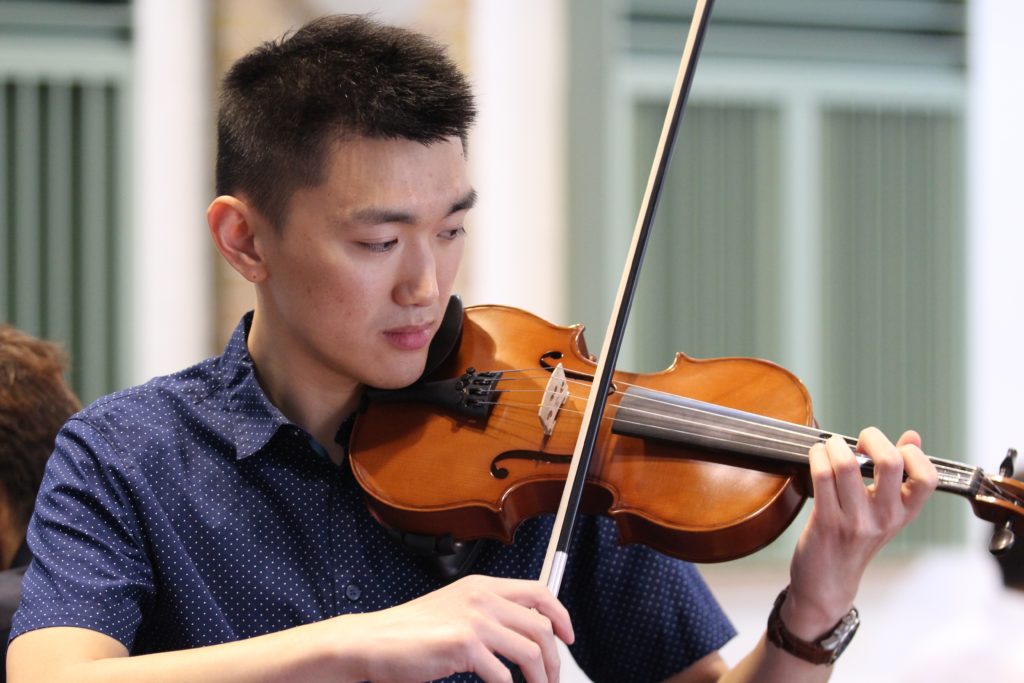 There are many reasons that people have for wanting to play the violin. Here are some of the reasons we hear most often:
There are many reasons that people have for wanting to play the violin. Here are some of the reasons we hear most often:
Regardless of where the initial inspiration for playing the violin comes from, if you drill down far enough, we also find that with almost any learner you'll uncover a desire to be able to communicate emotionally with other people through music (and by extension, through the violin).
Whatever the fundamental desire is that makes you want to play the violin, it's worth being aware of it. That way, when you hit difficult challenges in your practice (it will always happen!), you can keep motivated by staying focused on the big picture and on your long-term goals.
When you're learning violin for the first time, it can be difficult to remember which finger goes where. It also takes a long time to think about where to put each finger - especially if you're playing a new piece of music.
A good way around this is to get used to playing scales before you embark upon a piece of music. If you get used to playing a pattern of notes in the form of a scale, then your muscle memory will be stronger, and it will be easier for you to place the notes correctly when you play the piece.
When you're practising a new scale, it can still be really tricky to remember which note goes where. And that's where finger grids become useful! Grids give you a visual reference for each scale pattern. This makes it easier to get to the next note, as you have one less thing to remember! Here's an example of a scale grid in G Major:
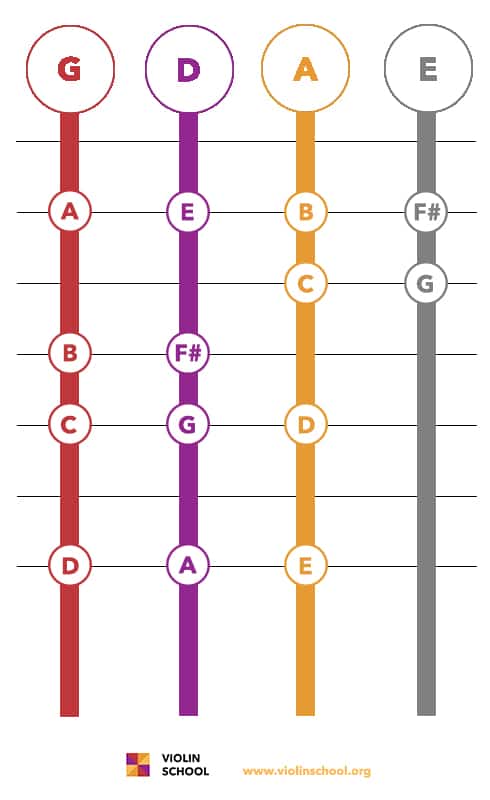
You can find more scale grids in the member section at ViolinSchool.com, but you can also create your own! Try drawing four vertical lines (one for each string), and then writing in the notes that you need for the scale you're currently working on.
The learning process never stops because there are so many layers of complexity in violin-playing. Each layer reveals more, and richer possibilities for musical expression.
At the same time, you don't want to get so wrapped up in the detail of one particular technique or that you lose sight of your overall music-making! Make sure you keep a balance between technical and musical at all times. One feeds the other.
One of ViolinSchool's learners, Susan Shaw, came up with this model for thinking about and describing the need to balance lots of complex details at the same time...
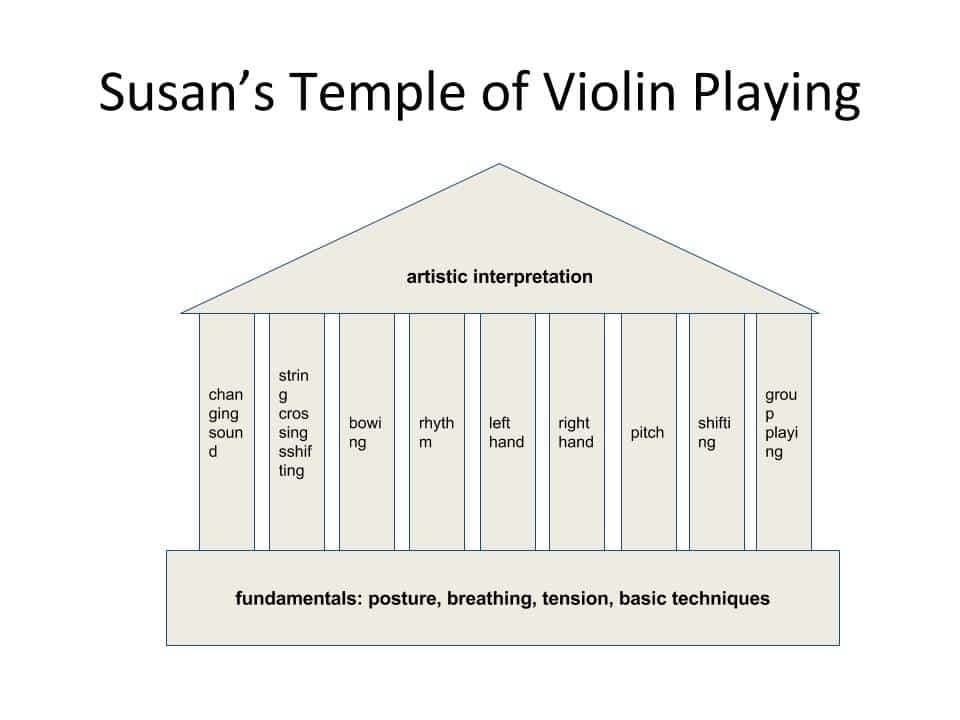
(imagine there are lots and lots of pillars, not just the 9 pictured here - one for each technique)
The principle is that you should always develop the 'pillars' of the temple at a roughly similar speed. Otherwise, you'll become too advanced at some techniques, or under-developed in other techniques, and your playing will become unbalanced (and the roof of the temple will slide off!).
Never become obsessed with making one technique perfect before moving on to the next. Otherwise, your technique will fall out of balance and you'll find it really difficult to play.
The Violin Guide and our online learning resources will help you to explore different aspects of technique layer-by-layer, and on your own terms. Everyone's body is different, so you need to adopt the core technical principles that are true for everyone, but then build up your technique in the way that's right for YOU.
That way, you can maximise your artistry and creativity in your violin playing, without you drowning in technical details. With this approach, your technique will build up and become brilliant over time, without you losing your overall perspective - including your approach to performance and to the music itself.
We'll be giving you everything you need to tackle the violin-playing adventure; all you need to do is to do it!
The Violin Orchestra starts this Saturday in London, UK. Check out our new video by Setareh Mood, to learn all about the project!
Here are some really useful exercises for shifting down from 3rd position.
What goes down must go up! Click here for the shifting up version!
[pdf-embedder url="https://www.violinschool.com/wp-content/uploads/2015/04/Shifting-Down-Exercises-from-3rd-Position-ViolinSchool.pdf" title="Shifting Down Exercises - from 3rd Position - ViolinSchool"]